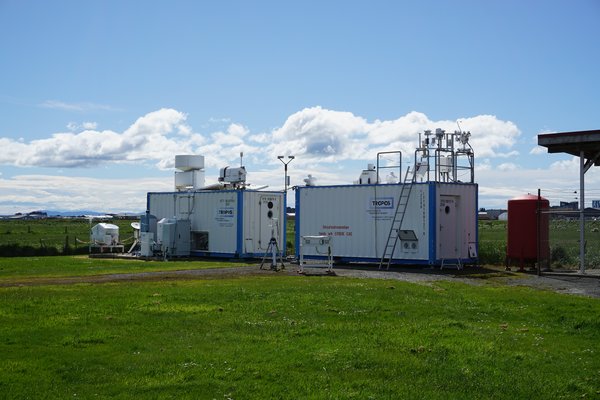
The Leipzig Aerosol and Cloud Remote Observations System (LACROS) at the MetService site at Invercargill. Picture: Tom Gaudek, TROPOS

Invercargill, 19.10.2025 – Martin Radenz, Tom Gaudek
all LACROS instruments started their operation during the first days of September
After a four-month journey around the globe, all containers of the mobile remote-sensing supersite LACROS (Leipzig Aerosol and Cloud Remote Observations System) arrived at their destination in Waihōpai/Invercargill, Aotearoa/New Zealand, on 21 August 2025. A four-person setup team, consisting of LACROS PI Patric Seifert, Annett Skupin, Philipp Sobek and Ronny Engelmann, managed that all instruments started their operation during the first days of September.
Cooperation with MetService New Zealand
The goSouth-2 campaign benefits from several partnerships with New Zealand institutions. LACROS operates at the site of the MetService close to the airport at Waihōpai/Invercargill. MetService as our host not only provides space for our containers but all essential facilities and infrastructure which is necessary for a successful deployment of LACROS. Further, MetService conducts decade-long observations the atmospheric state above the station, for example, by means of radiosonde launches twice a day. Those timeseries will allow to put the goSouth-2 observations into context and help to meet the research goals of goSouth-2. Vice versa, measurement data of TROPOS, such as profiles of horizontal wind by our Doppler lidar, are shared with MetService and the local airport authorities as well.
HALO-South: aircraft campaign in parallel
The LACROS setup was achieved in time of the beginning of the HALO-South aircraft campaign, where the German reasearch aircraft HALO operated out of Christchurch to probe trace gases, aersols and clouds over the Southern Ocean. Conveniently located en-route, the ground site was overpassed multiple times successfully. A final highlight during the last week of their campaign were two refuelling stops at Invercargill Airport. Refuelling closer to the target areas allows for longer time above the target regions over the ocean. During the short visit, aircraft and crew were welcomed by the LACROS and MetService team.
Promising LACROS observations during the first two months
The first weeks of operation already yielded successful and promising measurement data of all deployed instruments. The station is running well and except for a one-week measurement interruption of the cloud condensation nuclei counter (CCNC), continuous observations are now available. Local weather at Invercargill these days is characterized by regular rain and graupel showers, sunny hours in between, and typically moderate to strong westerly winds. The latter enable novel observations of marine-dominated aerosol layers above LACROS which will help to achieve one of the big campaign goals - to investigate the contrast between Southern Ocean and Australian air masses. Our whole team is excited about the upcoming data analysis of the first southern hemisphere fluorescence measurements with our lidar PollyXT.
Complementing Measurements by the EarthCARE Satellite
Another objective of LACROS in the southern hemisphere mid-latitudes is ground support of EarthCARE. On board that satellite, which is operated by JAXA and ESA, are a lidar, a cloud radar and two imagers, providing comparable measurements to LACROS with a global coverage. Regular overpasses within a distance of only a few kilometres to our station receive special attention as no comparable ground observations for a validation of EarthCARE in this part of the globe exist. Together with the in-situ observations of HALO-South around our stations, a truly unique dataset was acquired so far which is an achievement and something all involved actors can be proud of.
Martin Radenz, Tom Gaudek

The Leipzig Aerosol and Cloud Remote Observations System (LACROS) at the MetService site at Invercargill. Picture: Tom Gaudek, TROPOS